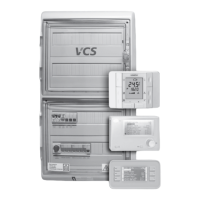97
Control units VCS
POOL UNITS – description of control
e VCS also allows the control of air-conditioning units
designed to ventilate swimming pools (swimming pools, water
parks, rehabilitation complexes with water procedures, etc.).
As the ventilation needs of these spaces are different from the
needs of ventilation of common areas (offices, restaurants,
etc.), the control system needs to be optimized according to
these requirements. erefore, the behavior of the control
system has been modified to create a unique control and
control system for pool units.
is section of the manual supplements the VCS control
system information from the perspective of HVAC pool control.
Regarding regulation, pool units are divided into two basic
variants. S and without integrated heat pump. e unit without
a "ventilating" heat pump only uses outside air to achieve the
desired humidity. e integrated heat pump unit uses both
the outdoor air and the circulation mode and the integrated
heat pump to achieve the desired humidity.
Other modifications only complement these two basic
variants. For example, additional cooling, reheater, etc.).
Unit operation modes
n Comfort (used for normal operation of air conditioning
systems to provide a comfortable environment for people in
the wind). In this mode, the minimum amount of fresh air is
preset to 30%..
n Economical (used for HVAC mode to ensure economical
operation when there is no need to provide comfortable
conditions - there are no persons in the ventilated area).
In this mode, the minimum amount of fresh air is preset to 0%.
For each mode, the set room temperature, the maximum
humidity in the room and the minimum amount of fresh air
are set separately.
e behavior of the control system is also different in these
modes and is optimized for maximum energy-efficient
operation of the unit. In Comfortable mode, emphasis is placed
on reaching the desired values with respect to the need to
supply fresh air for people in the ventilated area. In Economical
mode, people are not expected to be in the windspace. at
is why other management procedures can be used in this
mode to achieve the desired values for economical operation
and energy savings.
Temperature control
For pool units, room temperature control with limitation of
supply air temperature is used. e set room temperature
is set to Comfort and Economy. e supply air temperature
is not directly regulated but its intervention in the regulation
is in case of deviation from the set limits. e minimum and
maximum supply air temperature values are set in the control.
See Settings. list of data points.
Temperature control is superior to humidity control. In
some situations, the dehumidification performance may
exceptionally be reduced due to the higher priority of
temperature control. is state is signaled on the controllers.
Humidity control (Dehumidification)
For pool units, room moisture control is used. Desired humidity
is achieved in various ways according to the type of HVAC
pool units.
Pro-Vapor Pool Unit (Units without Integrated Heat Pump)
- e required humidity is achieved by mixing. By supplying
a sufficient amount of outdoor dry air. In addition, fan speed
control is used to increase the required power.
Pool unit with integrated heat pump and circulation flap - the
method of achieving the desired humidity varies according to
the selected unity mode:
Comfort Mode
1st stage of dehumidification - mixing + 2nd stage of fan speed
2nd degree of dehumidification - 100% mixing + 3rd stage
of fan speed
Economy Mode
1st dehumidification stage - circulation mode + running of the
heat pump + raising the speed to 2 degrees.
2nd stage dehumidification - mixing + 2nd stage of fan speed
Fan speed control:
for pool units, a constant flow rate control is usually used
in three preset steps. e transition between stages is fully
automated and is controlled according to temperature and
humidity requirements. e user has the option to switch
the unit on any power level. However, if it switches the unit
to maximum speed, it automatically blocks the possibility
of increasing the speed and optimizing the operation of the
HVACfrom an energy point of view. e ability to switch on
unity to the maximum speed is primarily possible for service
purposes and exceptional operational requirements.
e unit increases fan speed when dehumidifying. It can also
increase fan speeds in case of sufficient power of heating
components. is increases the heating power.
HVAC components control
regulation of individual components (mixing, water heating,
etc.) is based on the standard HVAC control. However, for a
pool unit there are some differences that are described below:
n Mixing damper and inlet/outlet damper
e dampers are continuously controlled according to the
temperature requirement. Furthermore, the position is
affected by the requirement for humidity. e mixing valve
may no longer be coupled with the inlet / outlet dampers.
eir mutual functions may be different in some situations
for pool units. For example, when the plate heat recovery is
active (pool units with integrated cooling).
Extreme temperature protection - at an outside temperature
of T <-10 ° C, the maximum amount of fresh air is limited
to 40%. is ensures greater control stability. Settings and
signaling see data. mixing points.

